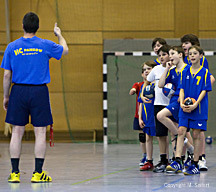Motivating Children to Participate in Organised Sport
After Isr ael's national sport development programme “Sport Flourishes" is almost half way through, ICSSPE’s President Uri Schaefer recalled the intentions of the programme founders and looked at what has been realised since the start in December 2014.
ael's national sport development programme “Sport Flourishes" is almost half way through, ICSSPE’s President Uri Schaefer recalled the intentions of the programme founders and looked at what has been realised since the start in December 2014.
On 8th December 2013, the Government of Israel decided to support a National Programme to promote and enhance sport among children. As part of the project, an unprecedented sum of 371 million NIS (approx. 80 million €) was invested by the Sport Betting Council, the Ministry of Finance and the Ministry of Culture and Sport over a period of five years.
The project's aims were to:
- increase the number of registered athletes older than 13 years by 50,000 by the year 2020;
- encourage children to engage in physical activity in targeted prioritised disciplines within the local municipalities;
- reduce the costs of participating in sport, and reducing the operating costs of sport clubs;
- register children to National Governing Bodies (NGBs) as of the age of 10, whilst strengthening the cooperation between NGBs and local communities and sport clubs.
In order to achieve the aims, the initiators encouraged communities across the country to establish new sport clubs with new activities. Special emphasis was put on the geographic and social periphery and on the advancement of girls in sport. Since the beginning of the programme, every female team and every team in the periphery of the country is entitled to receive additional financial funds on top of the ongoing support which every new sport team, individual or team sport receives.
The prioritised sports are:
- the two most popular sports – Football and Basketball;
- 10 newly and for the first time in Israeli sport prioritised sports: Gymnastics, Swimming, Track and Field, Judo, Sailing, Handball, Volleyball, Tennis, Cycling, and Cable Water Ski.
The project focuses on two different age groups:
- Level "A": ages 8 - 9 (Gymnastics from age 6 and Swimming from age 8); and
- Level "B": ages 10 - 12.
In level "A" the focus is on sport enrichment in schools, as part of the physical education curriculum. As this is the first phase of the sport socialisation process, the children are exposed to various physical activities, play, basic fundamental skills and sport games.
In Level "B", which is also mostly non-competitive, the children select their favourite sport, register with a national federation and learn how to practice while improving their motor skills in general and in the specific sport.
The budget is based on three different allocation methods:
A. standard allocation – Enabling all children to participate in the project as mentioned above in regards to girls and Israel’s geographic periphery;
B. subsidising local authorities;
C. rewarding coaches and instructors according to the given criteria.
The national sport development programme goes back to an unsatisfactory participation of young people in organised sport.
Data revealed that in 2013, the overall number of registered athletes was 84,000, indicating that in Israel less than one percent of the population were registered as active athletes in the sport.
Out of these, 30,000 were football players, 18,500 basketball players, 2,500 tennis players, 2,400 swimmers 3,200 gymnasts, 1,300 judoka, to name but a few. It is because of these findings that the Israeli Sport Authority in the Ministry of Culture and Sport initiated the National Project “Sport Flourishes”.
For each of the sports which are included in the programme, an expected number of active registered athletes was - in co-operation with the National Governing Bodies, the respective federation - set for the end of the project namely by 2020.
In summarising the first two years of the programme, the evaluation indicated that despite of some difficulties the programme is on the right track. Difficulties were analysed for example in sailing: it was inevitable that new sailing boats would be needed due to increase in the number of young athletes, but the budget was only developed for participation and not for equipment. Therefore it took some time before additional boats could be bought. Furthermore, when analysing the collected data, it has to be considered that football only joined the programme in 2015/16.
In 2014/15, the average registration rate of athletes (Level "A“) was 70% versus 91% in 2015/16. It was also reported that in 2015/16, more sport teams were established than in 2014/15. It was noticed that new sport clubs were established across the country with new sports. All these developments are in line with the original plans of the Israeli Sport Authority.
Finally, it was reported that in 2015/2016 73% of the teams were established in communities ranked 5th on a socio-economic scale from 1 to 10, or even lower versus 63% in the year 2014/15.
If at the end of the programme the number of registered athletes in organised sports will have grown significantly in each of the targeted sports, and participation of both, girls and boys, has increased in the Israeli periphery more than in the center of the country, the programme can be called a success and will hopefully lead to further, similar investments.
